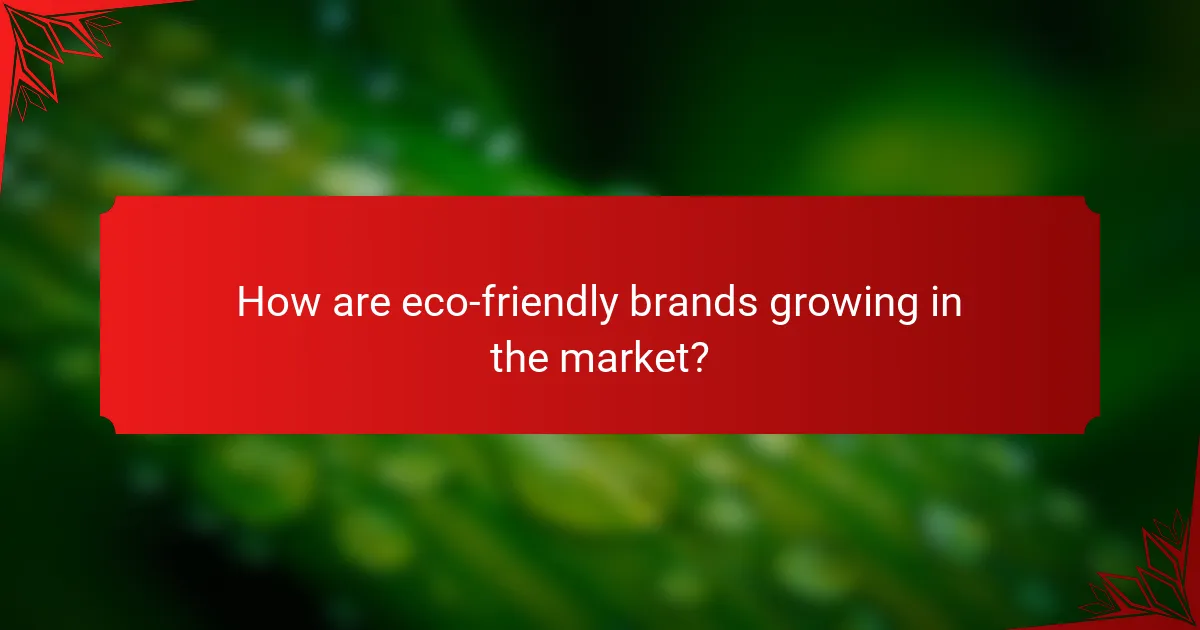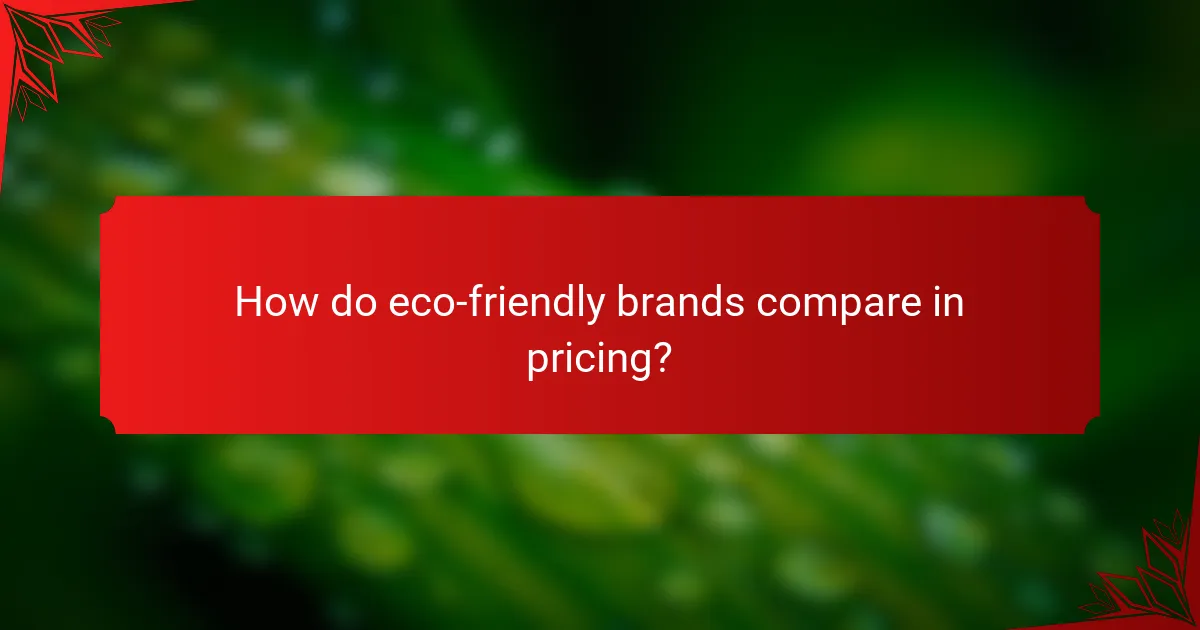The rise of eco-friendly brands reflects a growing consumer interest in sustainability, with many shoppers now prioritizing environmentally conscious choices. This trend is fueled by increased awareness of environmental issues and a shift towards ethical consumption, prompting brands to innovate and adapt to meet these demands. As social media amplifies the message of sustainability, consumers are more inclined to seek out and support brands that align with their values.

What are the current market trends for eco-friendly brands?
Current market trends for eco-friendly brands indicate a significant rise in consumer interest, with many prioritizing sustainability in their purchasing decisions. This shift is driving innovation and growth within the sector, as brands adapt to meet the demands of an increasingly eco-conscious market.
Increased consumer demand for sustainable products
Consumer demand for sustainable products has surged in recent years, with many shoppers willing to pay a premium for items that align with their values. Research shows that a substantial portion of consumers actively seeks out eco-friendly options, particularly in categories like food, clothing, and personal care.
Brands are responding by enhancing transparency in their supply chains and adopting sustainable practices. For example, companies are increasingly using organic materials and reducing packaging waste, which resonates well with environmentally aware consumers.
Growth in eco-conscious startups
The eco-friendly market is witnessing a boom in startups focused on sustainability. These new businesses often leverage innovative technologies and business models to address environmental challenges, such as waste reduction and resource conservation. Many startups are finding success by offering unique products that cater to niche markets.
Investment in eco-conscious startups is on the rise, with venture capitalists increasingly interested in funding companies that prioritize sustainability. This trend is fostering a competitive landscape where established brands must adapt to keep pace with agile newcomers.
Shift towards circular economy practices
There is a notable shift towards circular economy practices among eco-friendly brands, emphasizing the importance of reusing materials and minimizing waste. This approach encourages companies to design products with their entire lifecycle in mind, promoting recycling and repurposing.
Brands adopting circular economy principles often implement take-back programs and offer repair services, which not only reduce waste but also enhance customer loyalty. For instance, some clothing brands now allow customers to return old garments for recycling, thereby closing the loop on textile waste.

How are eco-friendly brands growing in the market?
Eco-friendly brands are experiencing significant growth due to increasing consumer demand for sustainable products and practices. This trend is driven by heightened awareness of environmental issues and a shift in purchasing behavior towards brands that prioritize sustainability.
Expansion of product lines in major retailers
Major retailers are expanding their product lines to include eco-friendly options, catering to a growing consumer base that values sustainability. This includes offering organic food, biodegradable household products, and sustainable fashion items.
For example, large supermarket chains now feature dedicated sections for organic and eco-friendly products, making it easier for consumers to choose sustainable options. This shift not only meets consumer demand but also enhances the retailer’s brand image.
Investment in sustainable technologies
Investing in sustainable technologies is a key strategy for eco-friendly brands looking to improve their environmental impact and operational efficiency. This includes adopting renewable energy sources, utilizing eco-friendly materials, and implementing waste reduction practices.
Brands that focus on innovation in sustainability often see long-term cost savings and improved customer loyalty. For instance, companies that use solar energy for production can reduce their carbon footprint while also lowering energy costs over time.
Partnerships with environmental organizations
Forming partnerships with environmental organizations allows eco-friendly brands to enhance their credibility and reach. Collaborations can involve joint campaigns, funding for conservation projects, or co-developing sustainable products.
These partnerships not only help brands align with environmental goals but also provide valuable marketing opportunities. For example, a clothing brand might partner with a wildlife conservation group to promote a line of apparel made from recycled materials, appealing to environmentally conscious consumers.

What factors influence consumer interest in eco-friendly brands?
Consumer interest in eco-friendly brands is primarily driven by awareness of environmental issues, a desire for ethical consumption, and the influence of social media marketing. These factors shape purchasing decisions and encourage consumers to seek out sustainable options.
Awareness of climate change impacts
As awareness of climate change grows, consumers are increasingly motivated to support brands that prioritize sustainability. Many individuals recognize the environmental consequences of their choices and seek products that mitigate harm to the planet.
For instance, brands that utilize renewable resources or adopt carbon-neutral practices often attract environmentally conscious shoppers. This shift in awareness can lead to a preference for products that are labeled as eco-friendly or sustainably sourced.
Desire for ethical consumption
Consumers today are more inclined to make purchases that align with their values, particularly regarding ethical consumption. This includes supporting companies that demonstrate fair labor practices, animal welfare, and sustainable sourcing.
For example, brands that are transparent about their supply chains and actively engage in social responsibility initiatives tend to build stronger loyalty among consumers. Shoppers are often willing to pay a premium for products that reflect their ethical beliefs.
Influence of social media and marketing
Social media plays a crucial role in shaping consumer perceptions of eco-friendly brands. Platforms like Instagram and TikTok allow brands to showcase their sustainability efforts and connect with audiences through engaging content.
Effective marketing strategies that highlight eco-friendly practices can significantly enhance brand visibility and appeal. Influencers promoting sustainable products can also sway consumer choices, making eco-friendly options more mainstream and desirable.

How do eco-friendly brands compare in pricing?
Eco-friendly brands often have higher pricing compared to conventional options due to the costs associated with sustainable sourcing and production practices. However, consumers are increasingly willing to pay a premium for products that align with their values of environmental responsibility.
Premium pricing for sustainable products
Many eco-friendly products carry a premium price tag, reflecting the investment in sustainable materials and ethical manufacturing processes. For example, organic cotton clothing can cost 20-30% more than regular cotton items due to the more expensive farming practices and certifications involved.
Consumers should consider that while the upfront cost may be higher, these products often offer better durability and longevity, potentially leading to savings over time. Additionally, brands that prioritize sustainability may provide transparency about their sourcing, which can enhance consumer trust.
Cost benefits of eco-friendly materials
Eco-friendly materials can lead to cost savings in various ways, particularly in energy efficiency and waste reduction. For instance, products made from recycled materials often require less energy to produce, which can lower overall production costs in the long run.
Furthermore, investing in eco-friendly products can reduce expenses related to health and environmental impacts. For example, using non-toxic cleaning supplies can decrease healthcare costs associated with chemical exposure. Consumers should weigh these long-term benefits against the initial higher prices when making purchasing decisions.

What are the challenges faced by eco-friendly brands?
Eco-friendly brands encounter several challenges that can hinder their growth and market acceptance. Key issues include supply chain sustainability and consumer skepticism regarding greenwashing practices.
Supply chain sustainability issues
Supply chain sustainability is a significant challenge for eco-friendly brands, as they must ensure that every step of their production process aligns with environmental standards. This often involves sourcing materials from suppliers who adhere to sustainable practices, which can be more costly and complex.
Brands may face difficulties in tracking the sustainability of their entire supply chain, leading to potential gaps in compliance. For example, a brand may use organic cotton but source it from a supplier that engages in unsustainable practices elsewhere.
Consumer skepticism about greenwashing
Consumer skepticism about greenwashing poses a major hurdle for eco-friendly brands. Many shoppers are wary of brands that claim to be environmentally friendly without providing transparent evidence of their practices. This skepticism can lead to distrust and reluctance to purchase products marketed as green.
To combat this, brands should focus on transparency and provide clear information about their sustainability efforts. Certifications from recognized organizations can help build credibility. For instance, brands that are certified by the Global Organic Textile Standard (GOTS) can reassure consumers about their commitment to eco-friendly practices.

What criteria should consumers consider when choosing eco-friendly brands?
Consumers should consider sustainability practices, transparency, and the overall impact of eco-friendly brands on the environment. Key factors include materials used, production processes, and the brand’s commitment to ethical practices.
Sustainability Practices
When evaluating eco-friendly brands, look for those that prioritize sustainable practices such as using renewable resources, reducing waste, and minimizing carbon footprints. Brands that implement circular economy principles, where products are designed for reuse or recycling, are often more sustainable.
For example, clothing companies that use organic cotton or recycled materials demonstrate a commitment to sustainability. Additionally, brands that engage in responsible sourcing and fair labor practices contribute positively to their environmental impact.
Transparency and Certifications
Transparency is crucial when selecting eco-friendly brands. Consumers should seek brands that openly share information about their sourcing, production processes, and environmental impact. Certifications from recognized organizations, such as Fair Trade or the Global Organic Textile Standard (GOTS), can help verify a brand’s claims.
Brands that provide clear information about their supply chain and sustainability efforts are more likely to be trustworthy. Look for labels that indicate compliance with environmental standards, as these can guide informed purchasing decisions.
Impact on Local Communities
Consider how eco-friendly brands affect local communities. Brands that support local economies, engage in community development, and promote social equity contribute positively beyond just environmental factors. This can include sourcing materials locally or investing in community projects.
Supporting brands that prioritize local impact can enhance the overall effectiveness of your eco-friendly choices. For instance, a brand that collaborates with local artisans not only reduces transportation emissions but also fosters economic growth in the community.



